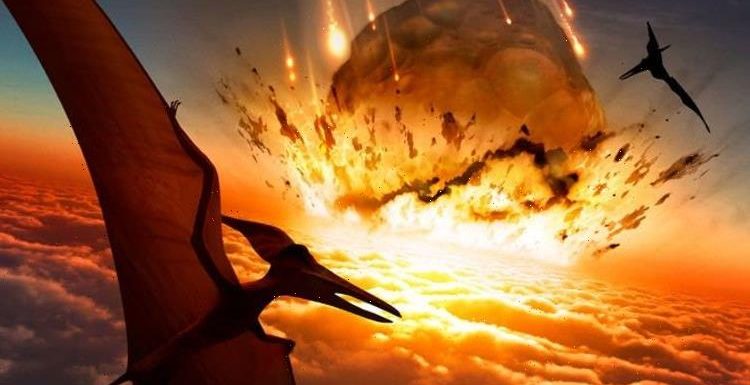
NASA: Expert says ‘little can be done’ about large asteroids
We use your sign-up to provide content in ways you’ve consented to and to improve our understanding of you. This may include adverts from us and 3rd parties based on our understanding. You can unsubscribe at any time. More info
Up until the end of the Cretaceous period, the mighty dinosaurs were the dominant life form on Earth. But all of that changed when a six-mile wide (10km) asteroid came crashing just off the coast of what is now the Yucatan Peninsula in Mexico. The so-called Cretaceous-Paleogene Impact is believed to have brought about the dinosaurs’ unexpected demise by causing devastating climate change for thousands of years.
This is the most widely accepted theory about what happened to the dinosaurs, though there has never been any agreement about where the asteroid came from and many questions remain unanswered.
Dr William Bottke of the Southwest Research Institute (SwRI) said last month: “Two critical ones still unanswered are: ‘What was the source of the impactor?’ and ‘How often did such impact events occur on Earth in the past?'”
Past studies have suggested the killer asteroid may have actually been a comet from the farthest edges of the solar system.
Others have argued the asteroid was the remnant of a larger object scientists have named Baptistina.


Now, scientists from the SwRI think they have finally traced the asteroid’s origin to the asteroid belt circling the Sun between Mars and Jupiter.
According to their study, the Cretaceous-Paleogene Impact may have been caused by a primitive and “dark” rock from our system’s main asteroid belt.
Using a mix of computer simulations and direct observations, the SwRI scientists found the asteroid belt sends large rocks hurtling our way 10 times more frequently than previously thought.
More importantly, the composition of these asteroids matches the Chicxulub asteroid that struck off the coast of Mexico.
The asteroid belt is home to thousands of ancient rocks ranging in size from 33ft (10m) to 329 miles (530km) across.
Dinosaurs roamed Earth on other side of Milky Way says scientist
According to NASA, the combined mass of all the asteroids within the belt is less than that of our Moon.
Another belt of primordial space rocks is found beyond the orbit of Neptune – the so-called Kuiper belt.
In total, NASA estimates there are more than 1.1 million known asteroids in the solar system.
And one of these rocks came crashing into our planet some 66 million years ago, according to David Nesvorny, a researcher at SwRI in Colorado.


Dr Nesvorny, who is the study’s lead author, was quoted by LiveScience saying: “I had a suspicion that the outer half of the asteroid belt – that’s where the dark primitive asteroids are – may be an important source of terrestrial impactors.
“But I did not expect that the results [would] be so definitive,” adding that this might not be true for smaller impactors.
The Chicxulub impact created a crater measuring about 90 miles (150km) across and triggered a mass extinction.
An analysis of material collected from the Yucatan Peninsula indicates the killer asteroid belonged to a family of carbonaceous chondrites – primitive space rocks rich in carbon.
In the new study, which will be presented in the November 2021 issue of Icarus, the researchers developed computer models simulating the escape of space rocks from the belt and towards the Earth.
The researchers found, on average, an asteroid bigger than six miles across (10km) is sent our way once every 250 million years.
The worrying discovery suggests such impacts are five times more likely than previously thought.
Dr Nesvorny said: “We find in the study that some 60 percent of large terrestrial impactors come from the outer half of the asteroid belt… and most asteroids in that zone are dark/primitive.
“So there is a 60 percent – three in five – probability that the next one will come from the same region.”
Source: Read Full Article